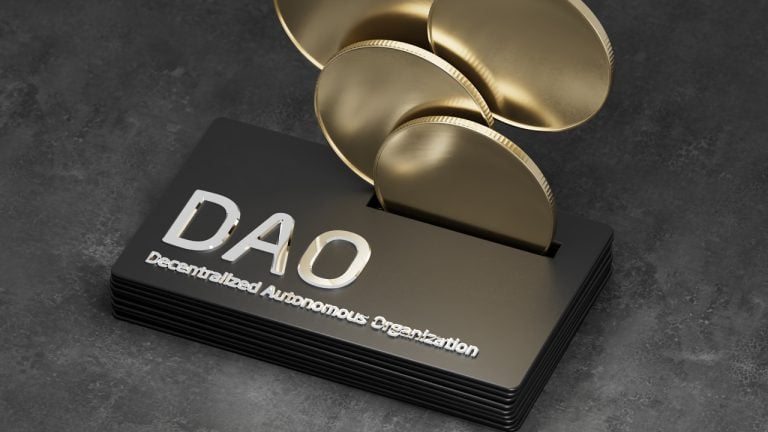
Gnosis founder Martin Köppelmann says Ethereum needs to move away from “centralized” L2s like Base and adopt native rollups.
Gnosis founder Martin Köppelmannn says implementing a web of 128 “native rollups” can save the Ethereum network from being captured by corporate interests and vanishing into obscurity.
Native rollups are layer-2 networks built to Ethereum’s native security standards, meaning that they’re composable, uncensorable, and economically aligned with the original ethos of Ethereum.
Unlike “centralized” rollups, which include L2s like Coinbase-incubated Base, or “based rollups” like Taiko — native rollups offer all of the inherent security and composability of Ethereum.

Whales moved more than $380 million worth of Bitcoin (BTC), Ethereum (ETH), Dogecoin (DOGE) and Gnosis (GNO) in a single day on Wednesday. A handful of whales moved huge sums of BTC onto or off exchanges, according to the blockchain-tracking platform Whale Alert. Top US crypto exchange Coinbase transferred 2,500 Bitcoin worth more than $74.3 […]
The post Whales Move Over $380,000,000 in Bitcoin, Ethereum, Dogecoin and Gnosis – Here’s Where the Crypto’s Headed appeared first on The Daily Hodl.

Proponents say PayPal’s PYUSD could see Ethereum become the money layer of the internet, while opponents argue that it’ll act like a poorly designed CBDC.
Paypal’s new Ethereum-based stablecoin, PYUSD has been seen as bittersweet news for the crypto community.
While it could finally see Ethereum find its place in mainstream adoption, it could also spell trouble for decentralization and personal control of assets, warns the community.
The new stablecoin, Paypal USD, was launched on Aug. 7 and is issued by Paxos Trust Co. — the firm behind Binance USD (BUSD). It’s built on Ethereum and “designed for digital payments and Web3,” with the firm saying it will soon be available to United States customers.
The launch has been seen as a boon for Ethereum adoption. Ethereum bulls Anthony Sassano and Ryan Sean Adams believe the ERC-20 stablecoin will push the blockchain closer towards becoming the money layer of the internet.
This is the Ethereum contract address for PayPal's stablecoin.
— RYAN SΞAN ADAMS - rsa.eth (@RyanSAdams) August 7, 2023
I can't believe i get to tweet that.
We've come so far. pic.twitter.com/S6kSqcV4ut
The number of daily active users on Ethereum currently hovers between 300,000-400,000, according to Etherscan.
However, Sean Adams noted that 430 million accounts actively use the online payment processor, which means that over 5% of the world’s 8 billion people could theoretically be onboarded onto Ethereum through PayPal’s new stablecoin.
Martin Koppelmann, the CEO and co-founder of Gnosis, added that by launching PYUSD on Ethereum’s base layer, Ethereum layer-2s will be able to interact with PYUSD too.
Others, including lawmakers, have seen it as another example of larger institutions embracing crypto, breathing new life into the traditional payments system.
In an Aug. 7 statement, Patrick McHenry, Chair of the United States House Committee on Financial Services said stablecoins like PayPal’s PYUSD “hold promise as a pillar of our 21st century payments system.”
#NEW: Chairman @PatrickMcHenry releases a statement following the announcement of PayPal's payment stablecoin launch.
— Financial Services GOP (@FinancialCmte) August 7, 2023
Read more https://t.co/LOF9ayUNnG pic.twitter.com/sRfSfLYbXQ
However, not everyone is convinced about PayPal’s new stablecoin.
Several smart contract auditors highlighted that PYUSD’s smart contract contains a 'freezefunds' and 'wipefrozenfunds' function which they claim is a textbook example of a centralization attack vector in Solidity contracts.
The new Paypal USD stablecoin has an "assetProtection" role which can wipe your balance in two transactions (first `freeze`, then `wipeFrozenAddress`)
— pashov (@pashovkrum) August 7, 2023
In smart contract security we call this a "centralisation attack vector" pic.twitter.com/RsmqvsnKvi
This concern was echoed by cryptocurrency researcher Chris Blec, who believes that PayPal will use the controversial functions where necessary.
Digital asset lawyer Sarah Hodder believes many characteristics of PayPal’s stablecoin resemble that of a censorship-enabled central bank digital currency. Another smart contract auditor noted that PYUSD’s smart contract can be changed by PayPal at any time.
I just read the PayPal USD terms of service.
— Sasha Hodder (@sashahodler) August 7, 2023
- full KYC
- custody by Paxos
- tied to your PayPal login
- PayPal can reverse any transaction
- claimed to be fully backed by actual USD
All the censorship capabilities of a CBDC, but launched by big tech instead of the gov't.
In October, PayPal was slammed for a controversial policy that could’ve seen users fined $2,500 for spreading “misinformation.” The firm later backpedalled, claiming the policy update was published “in error.”
Related: PayPal’s crypto holdings increased by 56% in Q1 2023 to nearly $1B
Meanwhile, Blockchain engineer Patrick Collins took a slightly more neutral view, suggesting that PayPal’s PYUSD could have been “epic” but believes some of the engineering choices were suboptimal — such as choosing an outdated version of Solidity to program the contract, making the contract upgradeable and not making it gas efficient.
Sassano also explained in a separate post that while PayPal's stablecoin is centralized, Ethereum users are free to choose whether they wish to use it or not.
Yes, PayPal's stablecoin is centralized.
— sassal.eth (@sassal0x) August 8, 2023
No, that doesn't make it any less cool that PayPal has a stablecoin.
Ethereum being a settlement layer for all types of value means that different types of assets will exist on the network & you get to choose which ones you want to use.
PayPal said PYUSD will be rolled out within the next few weeks.
ETH is currently priced at $1,825 which is approximately the same price at the time of PayPal’s announcement about 10 hours ago, according to CoinGecko. Only minor fluctuations have been observed in ETH’s price since then.
Magazine: DeFi Dad, Hall of Flame: Ethereum is ‘woefully undervalued’ but growing more powerful

Transactions on Optimism recently eclipsed the Arbitrum network, but do the project’s fundamentals support a sustainable growth trajectory?
Optimism (OP) is a Layer 2 scaling solution, which operates as a separate blockchain built on top of Ethereum. Despite having a smaller total value locked (TVL) than its rivals, Optimism may still have the potential to thrive in the increasingly competitive DeFi landscape.
Being one of the pioneers in the DeF space, Optimism initially gained an initial but had to contend with fierce competition. The project has been trailing behind other scaling solutions in terms of daily transactions for the past six months. However, in late July, the situation changed as Optimism finally overtook its main competitor Arbitrum and is showing signs of increasing demand from users.
The increase in Layer 2 activity on Ethereum has been significant, surpassing mainnet activity by more than four times, according to data from L2beat. Various solutions have emerged to address Ethereum's scalability challenges and each Layer 2 project focuses on different aspects such as privacy, specific decentralized applications and NFT marketplaces.
Consequently, the leaderboard of transactions and volumes constantly fluctuates based on demand, and each solution comes with its own advantages and drawbacks.
Optimism operates using rollups, bundling all transactions into a single transaction to be executed on the base layer, inheriting all security features from Ethereum. The philosophy behind Optimism assumes that all transactions are valid unless challenged and proven otherwise, allowing for cost-effective and fast transactions for users.

While Optimism and Arbitrum (ARB) rely on rollups, the core difference lies in Arbitrum's centralized approach where a single entity (sequencer) is responsible for submitting fraud proof. On Optimism, anyone can submit them.

Among the Layer-2 competitors, Optimism has been the standout performer since July 20, experiencing a 47% growth in daily transactions. This growth has enabled Optimism to surpass its competitor Arbitrum in daily transactions for the first time in 6 months.
Furthermore, the Optimism protocol has witnessed a surge in daily active addresses, with a 27.6% increase in 30 days, while Arbitrum's activity declined by 7.5%.

This trend indicates a potential shift in dominance, although drawing conclusions prematurely would be unwise. Arbitrum's main advantage lies in its much larger total value locked (TVL) compared to Optimism.
According to DefiLlama, Arbitrum currently holds a significant TVL of $2.35 billion, whereas Optimism's TVL is comparatively lower at $920 million. Arbitrum's dominance is especially evident in the decentralized finance (DeFi) applications it shares with Optimism, such as Uniswap and AAVE. Additionally, Arbitrum boasts an impressive $500 million TVL in the derivatives exchange GMX.
Two of the main reasons for higher demand on Optimism are increased use from Coinbase and Worldcoin. The project is also on track to implement important privacy mechanisms that could create another use case.
A pivotal moment for Optimism came with the launch of Coinbase's sandbox on July 21, providing developers with a test environment to build and deploy new applications on this Layer 2 solution. This initiative incentivizes the creation of new tools, applications, and protocols, fostering growth and innovation.
One of the projects utilizing Optimism as a scaling solution is Worldcoin, which has been gaining substantial attention. The token airdrop on July 26 further boosted activity on Optimism after supporting Uniswap on the Optimism mainnet. Worldcoin has also deployed most of its Safe wallets on Optimism. This adoption has contributed significantly to the daily activity on the network, accounting for around 40%.

Related: Worldcoin stuck after 70% drop from peak — More downside for WLD price?
Optimism's ecosystem is set to undergo several developments, including two proposals by O(1) Labs and RISC Zero to implement zero-knowledge proof systems. This move will provide the network with its own ZKP layers, akin to developments on Polygon (MATIC) and ZKSync.
The growth in active addresses on Optimism is a positive indicator for the network's success and the successful launch of the Worldcoin project marked a milestone for this scaling solution.
The surge in daily active addresses is also promising, signifying the network's continuous growth and potential opportunities with the successful implementation of its privacy solutions.
This article is for general information purposes and is not intended to be and should not be taken as legal or investment advice. The views, thoughts, and opinions expressed here are the author’s alone and do not necessarily reflect or represent the views and opinions of Cointelegraph.

Twitter users noticed thousands of Safe deployments to Optimism, leading to speculation that it may be an attack, but the developer of Worldcoin confirmed that this activity was merely an app migration.
Worldcoin is the cause of a slew of Safe deployments to the Optimism (OP) network over the past week, according to a June 27 social media post from Tiago Sada, head of product for Worldcoin developer Tools for Humanity.
The deployments had caused a stir on Twitter, as users wondered who was causing them and what their purpose was. Some Twitter users had speculated that it might be a Sybil attack or some kind of address-farming technique used to profit from coins sent to the wrong address.
Deploying more safes - steady lads https://t.co/W5DiQirrP0
— tiago sada (@tiagosada) June 27, 2023
A Safe (previously called “Gnosis Safe”) is a multisignature smart contract wallet. It is often used by development teams to ensure that multiple team members must sign off on each transaction that spends funds held in common or that upgrades an app. Safes are also used in some newer consumer wallets that employ account abstraction, such as ones that provide gas-free transactions.
Worldcoin is known to extensively use Safes, as it offers gas-free transactions to verified humans. The Worldcoin team recently announced that it was migrating its app from Polygon to Optimism.
Over the course of six days, from June 21 to June 27, Optimism address 0x86c5608362b3fbbeb721140472229392f754ef87 created over 50 subaccounts, each of which performed between 10,000 and 15,000 transactions, most of which created new Safe wallets. On the morning of June 26, on-chain researcher Spreek noticed the strange transactions and reported them to the community through a Twitter thread.
Spreek expressed bewilderment at the transactions, stating: “possible im misunderstanding something about this (gnosis safes are basically wizardry to me ngl).” In response, Luigi.eth, a contributor to the GnosisDAO — a decentralized autonomous organization — stated that the DAO alerted the Gnosis team, although the transactions didn’t look “malicious.”
Related: Sam Altman’s Worldcoin secures $115M for decentralized ID
The thread was shared by Parsec Finance founder Will Sheehan, who mentioned cryptically that “I think we can guess with p high probability what this is.” This caused speculation among Sheehan’s followers. One user thought the deployments might be a Sybil attack on the network, while another thought it might be some kind of attempt to farm addresses that may mistakenly be sent funds in the future.
It's a farm of all possible wrong-address sends, you m0rons. Imagine a DAO that, by mistake sends a cross-chain bridge swap from multisig to the same address on a different chain. Here all funds will be received by this minter. 100$ for a chance to get $10mln
— v3v3 (@vae_vic) June 27, 2023
Some users on both Spreek and Sheehan’s threads guessed that the deployments were not an attack. Instead, they theorized that these transactions might be caused by Worldcoin preparing to migrate its app to Optimism.
One user claimed “eyeball coin” might be the cause, apparently meaning Worldcoin, as the person stated, “folks were saying eyeball coin but dunno (or understand why).” Tools for Humanity is the creator of an iris-scanning device used for identity verification, called "the Orb," which is integrated with the Worldcoin app.
After less than an hour of this speculation, Tools for Humanity's Sada revealed what was really going on. Resharing Spreek’s original post, he stated, “Deploying more Safes — steady lads,” implying that the transactions were in fact caused by Worldcoin migration.
So it appears that Optimism users can breathe a sigh of relief. The network does not appear to be in the grips of a massive Sybil attack or address-farming scam at the moment, or at least not one related to these transactions.
Optimism upgraded to its new “Bedrock” version on June 6, bringing lower fees and shorter deposit times. Its transaction count has increased dramatically since the upgrade.

Bridge protocols LayerZero, Celer, Wormhole, LiFi, and others have already committed to implementing the new protocol.
Gnosis, the team behind Gnosis Safe multi-sig and Gnosis Chain, has launched a hash oracle aggregator for blockchain bridges, according to an announcement from the company. In a conversation with Cointelegraph, Gnosis CEO Martin Köppelmann stated that the new aggregator should make bridges more secure by requiring more than one bridge to validate a withdrawal before it can be confirmed.
Multiple bridge protocols have already committed to integrating with Hashi, including Succinct Labs, DendrETH, ZK Collective, Connext, Celer, LayerZero, Axiom, Wormhole and LI.FI, according to the announcement.
Over $2 billion was stolen from bridges in 2021 and 2022, according to a report by Token Terminal. Bugs in the code have caused some bridge hacks, whereas others have been caused by the attacker taking over a multi-sig governance wallet.
According to Köppelmann, Hashi can provide the first step towards making these cross-chain transactions more secure throughout the blockchain ecosystem, by requiring withdrawals to be validated by multiple bridges instead of just one:
Hashi is about essentially creating this aggregator that can use different bridges and basically say they all need to agree to the same message [...] If they do, great, then we can be really, really certain that this message is actually real and if they disagree [...] Then we know we need to escalate to governance, we need to halt the bridge.
Köppelmann also emphasized that Hashi helps to prevent multi-sig governance attacks because it allows a protocol to prevent governance from intervening if there is no disagreement between individual bridges.
“Here you can have this nice tradeoff where you say ‘the governance is not allowed to do anything,’ so it cannot interfere with the system unless there is explicitly a conflict or a bug," he explained. "So as soon as those bridges that are supposed to report on the same thing [...] Disagree, well then governance is allowed to interfere, otherwise governance has no role. That’s Hashi.”
Related: Uniswap’s BNB deployment should use multiple bridges, claims LIFI CEO
Hashi is open source and available on GitHub.
The idea of a multi-bridge aggregator rose to prominence during the Uniswap bridge debate in December and January. Although Wormhole was ultimately chosen as Uniswap’s bridge provider, representatives from Celer, LiFi, and deBridge, as well as other participants concluded that a multi-bridge aggregation solution needed to be implemented going forward.
 Since people are once again talking about self-custody as one of crypto’s unique strengths, I would like to remind everyone about an equally important fundamental value proposition of crypto that, in the early days, was touted as the killer feature. I’m talking about censorship resistance. The following opinion editorial was written by Bitcoin.com CEO Dennis […]
Since people are once again talking about self-custody as one of crypto’s unique strengths, I would like to remind everyone about an equally important fundamental value proposition of crypto that, in the early days, was touted as the killer feature. I’m talking about censorship resistance. The following opinion editorial was written by Bitcoin.com CEO Dennis […] Since January 2022, the entire crypto economy has shed $1.36 trillion in value, as the market capitalization dropped from $2.34 trillion to today’s $979 billion. While the crypto economy is down in value, trade volumes are lower, and the value locked in decentralized finance (defi) has shed billions, treasuries held by decentralized autonomous organizations (DAOs) […]
Since January 2022, the entire crypto economy has shed $1.36 trillion in value, as the market capitalization dropped from $2.34 trillion to today’s $979 billion. While the crypto economy is down in value, trade volumes are lower, and the value locked in decentralized finance (defi) has shed billions, treasuries held by decentralized autonomous organizations (DAOs) […]
Singapore-based digital asset exchange Crypto.com is continuing its listing spree and rolling out support for another red-hot altcoin. On Thursday, the exchange listed the native asset of Gnosis (GNO), a protocol built on Ethereum (ETH) that’s designed as a decentralized prediction market. GNO, which is used for transferring value and validating transactions on the Gnosis […]
The post Digital Assets Exchange Crypto.com Adds New Support for Surging, Under-the-Radar Altcoin appeared first on The Daily Hodl.

A decentralized communications network is surging on the news that top US crypto exchange Coinbase will list its native token. In an announcement, Coinbase says Sylo (SYLO) and four other Ethereum (ETH)-built tokens will start trading paired with Tether (USDT) once appropriate liquidity conditions are met. According to the project website, Sylo’s priority is ensuring […]
The post Little-Known Ethereum Metaverse Altcoin Soars As Coinbase Launches Support for Low-Cap Crypto Projects appeared first on The Daily Hodl.